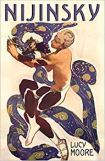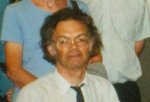Nijinsky by Lucy Moore
| Nijinsky by Lucy Moore | |
|
| |
| Category: Biography | |
| Reviewer: John Van der Kiste | |
| Summary: A biography of Vaslav Nijinsky, often regarded as the greatest dancer of the twentieth century, yet whose career was sadly cut short by mental health issues. | |
| Buy? Yes | Borrow? Yes |
| Pages: 324 | Date: May 2013 |
| Publisher: Profile | |
| ISBN: 9781846686184 | |
|
| |
The name Nijinsky is synonymous with dance from the last days of imperial Russia. I must confess to knowing little about him until I read this, the first biography of him for nearly forty years, and for me it was a surprise to learn that his career was so tragically brief.
Born in 1889, at the age of nine he joined the Imperial Ballet School in St Petersburg, at that time the world’s finest. In 1907 he became a member of the imperial ballet, and two years later joined the Ballets Russes, a new company started by the impresario Sergei Diaghilev, who wanted to stage work in Paris, where he knew that he would easily outshine local productions which were nowhere near the high standards maintained by the imperial Russian ballet. Quiet and unassuming offstage, Nijinsky became the company's star male dancer. He soon began choreographing his own ballets, notably 'L'après-midi d'un faune', which caused some controversy because of its allegedly obscene finale.
Nijinsky and Diaghilev became lovers for a while, but while the company were on tour in South America the former married Romola de Pulszky, daughter of a Hungarian actress, and a furious Diaghilev dismissed him from the company. The First World War proved a difficult time for him personally and professionally. As an enemy alien he was interned in Hungary under house arrest, and only allowed to leave after the intervention of a forgiving Diaghilev who was prepared to have him back to perform in an American tour.
By this time he had formed a company of his own, but managing tours as an impresario, coupled with the frustration of not being able to dance himself any more, unsettled him to the extent that he began a long descent into mental illness. Diagnosed with schizophrenia, he spent much of the rest of his life in asylums and psychiatric hospitals. Apart from a brief and more or less spontaneous dance during the Second World War for a group of Russian soldiers near Vienna whom he heard playing traditional folk tunes, his career was over. He died in a clinic in London in 1950.
The biography of any character whose career coincided with the turbulent years of the early twentieth century is bound to be set partly against a backdrop of what was happening at the time, and this book is no exception. For me, there was one particularly illuminating episode at around the time of ‘Bloody Sunday’ in St Petersburg in 1905 and the demonstrations which followed it. Nijinsky inadvertently found himself in the front line of one such protest, staged by a group of railway workers who were being kept at bay by footsoldiers and Cossack cavalrymen. He was taken for a protestor when a Cossack lashed at him with his whip and narrowly escaped being trampled beneath the hooves of his attacker’s galloping horse. The next day he and his classmates had to search through mutilated corpses on marble slabs in the morgues, looking for the sister of a colleague who had been missing since the demonstration and was never found.
Just as poignant in a different way are entries from his diary when mental illness took hold. In one, he described walking through trails of blood in the snow when God told him to jump into the abyss, but he fell and was stopped by a tree in his path, to him a sure sign of a miracle. In another, he wrote after what was to be one of his last performances that the audience had come to be amused, but he danced frightening things, explaining that they were frightened of me and therefore thought that I wanted to kill them...I loved everyone, but no one loved me, and therefore I became nervous.
The diagnosis was one of schizophrenic disorders – hallucinations, delusions of many kinds, disorganised language and behaviour; he was probably bipolar, and had he lived in a later age, he would have probably been diagnosed as on the autism spectrum. Throughout the sad later years, moving from one country to another, his wife seemed increasingly obsessed by the hope that he might return to sanity and resume his dancing career, but it was not to be. One can only be thankful that this man, who had become a mere shell of his former self and was described by one journalist who met him as like a docile child, passed away at a comparatively early age.
The author has dealt sensitively with her subject, a glorious, glowing emblem of youth and talent, cut off in its prime, with much illuminating detail about his life and times, the ballet which he made his career all too briefly, and the harrowing years of impaired health and awareness of the world around him. It makes for a lively but at the same time very moving read. I was also amused to note that near the end of the book she allows her imagination free rein with a four-page libretto for a ballet based on Nijinsky’s life.
If this book appeals then you might also enjoy Diaghilev: A Life by Sjeng Scheijen
Please share on: ![]() Facebook,
Facebook, ![]() Twitter and
Twitter and
![]() Instagram
Instagram
![]() You can read more book reviews or buy Nijinsky by Lucy Moore at Amazon.co.uk Amazon currently charges £2.99 for standard delivery for orders under £20, over which delivery is free.
You can read more book reviews or buy Nijinsky by Lucy Moore at Amazon.co.uk Amazon currently charges £2.99 for standard delivery for orders under £20, over which delivery is free.
![]() You can read more book reviews or buy Nijinsky by Lucy Moore at Amazon.com.
You can read more book reviews or buy Nijinsky by Lucy Moore at Amazon.com.
Comments
Like to comment on this review?
Just send us an email and we'll put the best up on the site.


